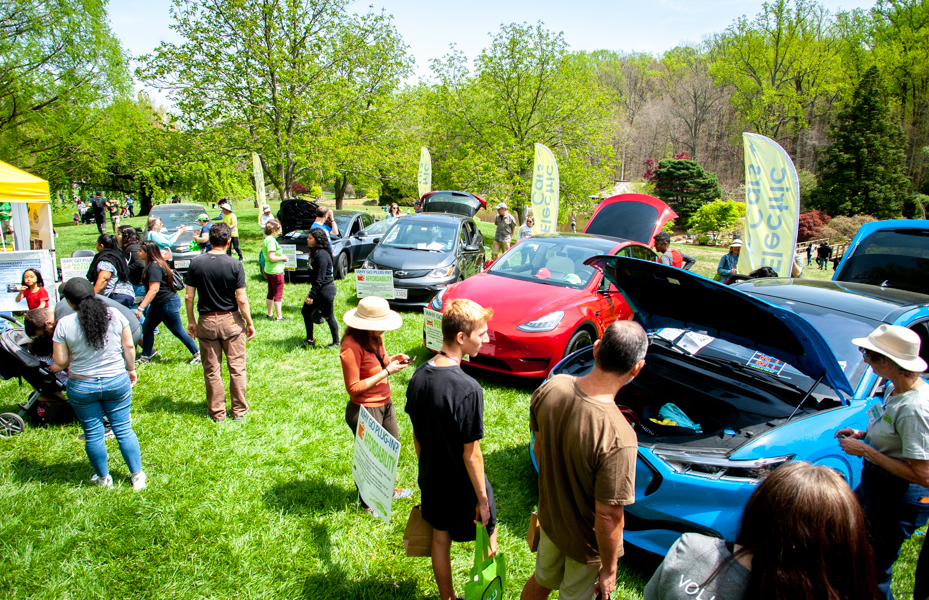Doug Boucher
Article for the September 2023 issue of the Monocacy Monocle
In September 2012, there was something new at Poolesville Day. Along with the marching bands, the classic cars, the campaigning politicians and the riders on horseback, two electric vehicles – both of them Nissan Leaf sedans – were part of the parade. Sponsored by the then-still-new local environmental group Poolesville Green, they showed that ordinary cars didn’t need to use gasoline exploding in an internal combustion engine, producing lots of noise, heat and carbon pollution, in order to run. They could simply be plugged in and “fueled” with electricity, just like our TV sets, our bedside lamps, our washing machines and our laptop computers.
Besides having the two EVs in the parade, Poolesville Green also distributed an information sheet on EVs, prepared by the EV Association of Greater Washington. It listed 13 different kinds of vehicles, but that was a bit optimistic. Two of those vehicles were motorcycles, three were plug-in hybrids (running partly on electricity and partly on gasoline) and four others were not currently available on the market.
Nonetheless, it was the start of a rapidly growing trend. By the following year the number of EVs in the parade had jumped to 10, with several different models. By 2014 the number of EVs was already too large for them all to be in the parade, and that same year the EV display had officially become part of National Drive Electric Week (NDEW). As in other meet-ups across the country, EV owners were giving people rides in their cars, explaining how they were saving them money (not just on gas, but from lower maintenance costs as well), discussing the pros and cons of different models, and answering all sorts of questions based on their own personal experience.
The Poolesville Day EV show, and National Drive Electric Week, have continued to grow and diversify over the past decade. By 2022 the Poolesville Day gathering had become the largest NDEW event in the nation, with 200 vehicles participating. That year’s EV information sheet listed 40 models of completely electric cars, with 16 of them costing less to buy than the price of the average American gasoline car ($ 48,000). Besides the 40 cars, there were also 12 models of trucks and 8 kinds of motorcycles. The EV show included police cars from local departments, which appreciated the power and rapid acceleration provided by electric motors as well as their lower costs to run and maintain. In cooperation with Wells Fargo Bank, an EV was given to a U.S. Army veteran.
Visitors to Poolesville Day were able to ride an electric RideOn bus from satellite parking at the swimming pool or Catholic Church to the center of town and participate in a variety of free drawings of electric lawn equipment, home charging installations and other accessories. The show included not only dozens of owners describing their vehicles and experiences, but also panel discussions on related questions such as home charging and tax subsidies.
For 2023, there will be even more. Poolesville Day attendees will be able to see an award-winning EV race car built by young women from the Society of Women Engineers chapter at Wheaton High School. This hand-built vehicle recently took first place in an international competition in Dubai.
There’ll also be the opportunity, through a cooperative effort of Poolesville Green and Redwood Materials, to recycle your old small rechargeable electronic gear — cell phones, tablets and the like – for the recovery of the lithium in their lithium-ion batteries. As the saying goes, the world’s biggest lithium and cobalt mine is in America’s junk drawers. So, you can clear out your old collections of obsolete electronics (not just those with Li-ion batteries, but also the truly ancient ones with NiCad and nickel-metal hydride ones and at the same time contribute to powering future electric vehicles. In collaboration with Crochet4Change teens, plastic bags will also be collected for transformation into sleeping mats.
There’ll also be panel discussions of questions that are important in making the switch to an EV, such as how to shop for one, facts and myths about road tripping, and “But what about the batteries?”
Many of us enjoy seeing antique cars – Corvettes from the sixties, the fifties sedans with the giant fins, and even restored Model Ts – in parades such as the one at Poolesville Day. But here in Poolesville, we have an additional opportunity that few other towns offer. We can see not only the great cars of the past, but also those of the future. And every year, those are more and more not just the promise of the future, but the reality of today.

